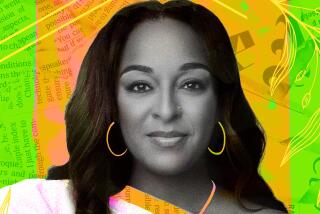Story of Phillis Wheatley, an 18th-Century Black Teen Poet
- Share via
Phillis Wheatley: Negro Slave by Marilyn Jensen (Lion Books: $14.95, hardcover; 233 pages)
The story of Phillis Wheatley has everything going for it. Among America’s first important black writers, she was a slave and a child prodigy, she lived at an important time in history and most of what she accomplished in her short life she did while she was still in her teens.
“Phillis Wheatley: Negro Slave” as biography is an impressive work of background research, clearly a labor of love. Marilyn Jensen has immersed herself in the subject, citing in the bibliography 44 references on the poet, on Colonial life in Boston, on the background of the American Revolution and on 18th-Century London, all of which she has woven into novel form. But “Phillis Wheatley” structured as fiction sometimes works and sometimes doesn’t.
Phillis was brought by slave ship to Boston in 1761 when she was about 8. John Wheatley, a prosperous merchant, bought the sickly, terrified child for his wife, Susannah. It wasn’t long until the family recognized her precocity.
Writing Poetry at 12
By the time Phillis was 12, she was reading everything in her master’s library and had begun to write poetry. (Her first poem began: “While an intrinsic ardor prompts to write / The Muses promise to assist my pen.”) At 14, a council of learned Bostonians examined her to verify her amazing intellect--unusual in any child, unthinkable in a black slave.
At 16, she was translating Ovid’s poems from Latin into English. At 17, her first collection of poems was published. At the age of 20, Phillis was invited to London, where she was the toast of the literary set. But that was the peak of her career--and of her life.
Receiving word that her mistress was gravely ill, Phillis returned to Boston. The American Colonies were moving inexorably toward war. Following the deaths of Mrs. Wheatley, Mr. Wheatley and their daughter, Phillis was free, and she was able to accept the attentions of John Peters, a handsome, intelligent but moody black man.
The courtship culminated in marriage in the midst of war; three children were born, but it was not a happy marriage. Her children dead, her books out of print, her muses silent, Phillis Wheatley died alone and impoverished in 1784, at the age of 31.
Jensen captures well Phillis’ problems of identity: a black girl taken into a white home where she was part family, part servant--and, as her fame spread, part novelty, sometimes petted and admired, sometimes the victim of cruel prejudice.
Citizenry in Wartime
Jensen also provides a dramatic account of what life was like for the ordinary citizen during and after the war.
Where this biography-as-novel goes wrong is in the stylistic technique. The story is plagued by a shifting viewpoint. The story begins inside Susannah Wheatley’s head as she prepares to accompany her husband to the slave market. A few chapters later the viewpoint becomes that of Phillis. Generally that’s where it stays until it shifts back to Susannah for a page or two, and far more abruptly and disconcertingly to John Peters, the man Phillis marries.
The style occasionally smacks of Gothic romance, such as the scene following Phillis’ marriage when John sweeps his bride into his arms, “her long suppressed passion rose to meet his, and the two became one.” Much attention is lavished on the style of ruffled petticoats, none at all on the style of Phillis’ poetry, modeled on Alexander Pope’s.
Phillis Wheatley was a brilliant misfit who belonged to neither white world nor black, a disturbing example of genius encouraged to flower and then allowed to wither. Young readers deserve to know about her. Even with its flaws, this book is a worthwhile introduction.
Meyer’s most recent young adult novel is “Denny’s Tapes.”
More to Read
Sign up for our Book Club newsletter
Get the latest news, events and more from the Los Angeles Times Book Club, and help us get L.A. reading and talking.
You may occasionally receive promotional content from the Los Angeles Times.









